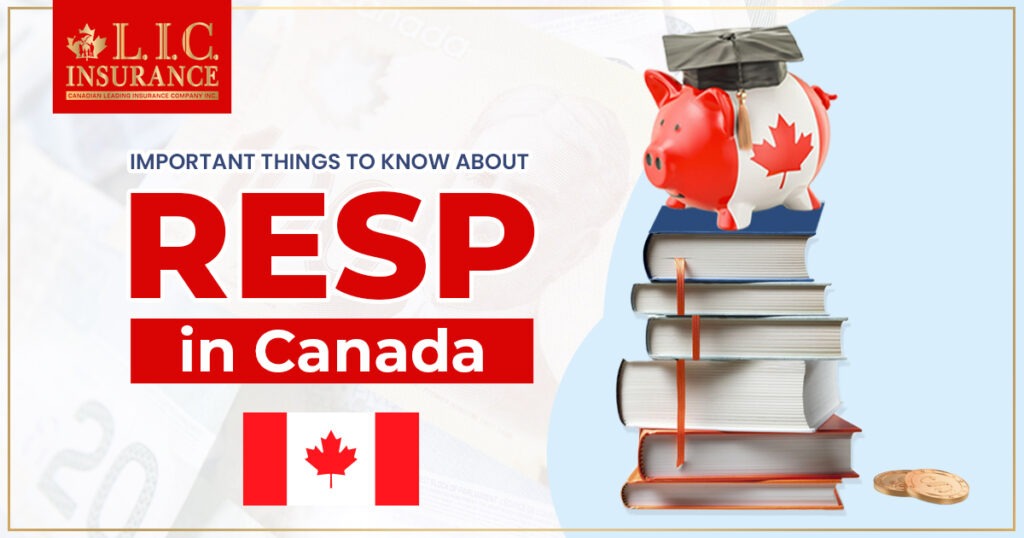
Are you a parent or guardian in Canada with dreams of sending your child to college or university? The cost of higher education is constantly on the rise, and saving for it cannot be easy. But fear not! You can have access to a fantastic tool to help you save for your child’s future education called the Registered Education Savings Plan (RESP). Here, we will take you through everything you should know about RESPs, so that you can easily make informed decisions to secure your child’s educational dreams.
Understanding the RESP Basics
Before going deep into RESP details, let’s start with the basics.
What is an RESP?
RESP stands for Registered Education Savings Plan. It’s a special savings account designed to help Canadian parents and guardians save for their child’s post-secondary education. The government created RESPs to make it easier for families to save for higher education by providing incentives and tax benefits.
Who Can Open an RESP?
The good news is that almost anyone can open an RESP for a child. Parents, grandparents, other family members, or even family friends can contribute. There are no age restrictions for contributors or beneficiaries, meaning you can open an RESP for a child at any age.
How RESPs Work?
Now that you know what an RESP is, let’s explore how it works.
Contributions
Contributions are the money you put into the RESP. You can contribute as much or as little as you want, whenever you want, with no annual contribution limits. However, there is a lifetime maximum contribution limit of $50,000 per beneficiary.
Government Grants
One of the most significant advantages of an RESP is the government grants that come with it:
Canada Education Savings Grant (CESG): This grant contributes up to 20% of your annual contributions to a maximum of $500 per year, per beneficiary, and a lifetime maximum of $7,200 per beneficiary.
Canada Learning Bond (CLB): Designed for children from low-income families, the CLB offers a grant of up to $2,000.
Investment Earnings
The money in your RESP, including government grants and your contributions, grows tax-free until your child starts post-secondary education. This tax-deferred growth can significantly boost your savings over time.
Types of RESPs
There are two main types of RESPs in Canada:
- Individual RESP There are two main types of RESPs in Canada:
- Family RESP A family RESP is designed for families with more than one child. It allows you to name multiple beneficiaries (usually siblings), and government grants can be shared among them. This type of RESP simplifies the process and maximizes government grants for families with multiple children.
RESP Investment Options
Choosing the suitable investments for your RESP is a crucial decision. Here are some options:
Guaranteed Investment Certificates (GICs)
GICs are low-risk, fixed-term investments that provide a guaranteed return on your money. They’re a good option if you’re risk-averse.
Mutual Funds
To invest in a broad portfolio of stocks, bonds, or other securities, mutual funds collect the funds of many different people. They carry some risk but have the potential for bigger profits.
Exchange-Traded Funds (ETFs)
ETFs are similar to mutual funds but trade on stock exchanges like individual stocks. They typically have lower fees and are a good option for long-term investors.
Individual Stocks and Bonds
If you are knowledgeable about the stock market, you can choose to invest directly in individual stocks and bonds.
Savings Accounts
Some RESPs offer a savings account option, which is low-risk but may offer lower returns than other investment options.
When selecting investments, consider your risk tolerance, time horizon, and financial goals. Diversification can help spread risk and optimize your returns.
RESP Withdrawals
When your child is ready for post-secondary education, you can start making withdrawals from the RESP to cover their educational expenses. Here’s what you need to know:
Educational Assistance Payments (EAPs)
EAPs include government grants, investment earnings, and accumulated income. They are taxable in the hands of the beneficiary, who typically has a lower income during their studies, resulting in little or no tax on the withdrawals.
Post-Secondary Education Program
Your child must be enrolled in a program at a designated educational institution, such as a college or university, to qualify for EAPs.
Proof of Enrollment
You will need to provide proof of enrollment to your RESP provider to make EAP withdrawals.
Unused Contributions
If your child decides not to pursue post-secondary education, you can typically withdraw your contributions tax-free. However, government grants will be returned to the government, and investment earnings will be subject to taxes.
Get The Best Insurance Quote From Canadian L.I.C
Call 1 844-542-4678 to speak to our advisors.

RESP Rules and Limitations
Understanding the rules and limitations of RESPs is crucial:
Contribution Limits
While there’s no annual contribution limit, there is a lifetime limit of $50,000 per beneficiary.
Beneficiary Age Limit
While there’s no maximum age limit for beneficiaries, government grants are only available until the beneficiary turns 17.
Unused Grants
If your child doesn’t pursue post-secondary education, you may be required to return government grants, but you can keep the investment earnings and your contributions.
RESP Termination
RESPs have a maximum lifespan of 36 years. If not used within this time frame, the plan must be terminated, and any remaining assets are distributed to the subscriber or the beneficiary.
Educational Eligibility
Not all educational programs qualify for RESP withdrawals, so checking the eligibility criteria is essential.
RESP and Taxes
RESPs offer tax advantages to boost your savings:
Tax-Deferred Growth
Investment earnings in an RESP grow tax-free as long as they remain in the plan.
Taxation of EAPs
While EAPs are taxable when withdrawn, they are typically taxed in the hands of the beneficiary, who often has little or no taxable income during their studies.
Tax Credits
Some provinces offer tax credits for contributions to an RESP, providing additional savings.
- Visit their website and have a look at their customer reviews. This will give you a better insight into how they have worked with their previous customers.
- Check if the insurance broker works with several companies; if they do, that would mean that they are well-established in the industry.
- You can ask them for proof of their experience, as all registered insurance brokers must possess a minimum set of qualifications.
- Ask for a consultation, and during the first meeting, you can resolve all the queries you may have.
- Also, when you are searching for an insurance broker, you should pay close attention to their availability, as well as how long they take to return phone calls or respond to emails. Choose an insurance broker who is always prompt with their replies.
Planning for RESP Success
Here are some tips to make the most of your RESP:
- Start Early: The earlier you begin contributing to an RESP, the more time your investments have to grow.
- Maximize Government Grants: Contribute enough to receive the maximum CESG and CLB grants.
- Diversify Investments: Spread your investments across different asset classes to reduce risk.
- Stay Informed: Keep yourself updated with RESP rules and regulations, as they may change over time.
Why open an RESP for your children?
The savings in the RESP grows Tax-Free
A Registered Education Savings Plan is a tax-free investment account created to help parents, grandparents, or other family members, including friends, save money for their children/grandchildren or loved one’s post-secondary education. Throughout the plan, the maximum contribution can be $50,000 per child. Just like any other investment account, the investments grow tax-free, and when you decide to take out the funds from the RESP, your children will be taxed, but since they do not earn any sort of income, the investment gained is free from any tax or very minimum.
Grants from the government can boost your investment savings
The best part of the RESP is that you are not the only one contributing; the government contributes 20% as well. The Canada Education Savings Grant (CESG) contributes up to $500 annually, i.e., 20% of $2,500. The lifetime maximum contribution from the government is $7,200 per child. We do not need to worry if you skip out on a year of contributions, the maximum contribution that can be carried each year is $1,000, allowing you to easily make up for the missed contribution for the following year.
The process of opening an RESP is very simple
To open a Registered Education Savings Plan (RESP) for your child, all that is required is your child’s Social Insurance Number (SIN) and an RESP form from a financial institution. It is ideal for opening a family plan if you have more than one child. You have the freedom to make more than one contribution at a time, and you don’t need to pay a similar amount for each child in their RESP. Usually, to be eligible for the government grant, you would be required to contribute $2,500 annually. However, if you struggle to make sizable contributions, even a small one can still make a big difference in the long run. Many financial institutions will allow making contributions as low as $25 per month for each child. Avoid contributing as you will be taxed 1% every month on the share of your over-contribution until you withdraw the funds.
Even if your children do not wish to pursue their post-secondary education, you can withdraw the funds, and you will not be taxed. However, the grant money earned in RESP will have to be returned to the government.
For further information on RESPs or to open one, please do not hesitate to contact the team at CanadianLIC.
Get The Best Insurance Quote From Canadian L.I.C
Call 1 844-542-4678 to speak to our advisors.
To Sum Up
You can use a Registered Education Savings Plan (RESP) to make post-secondary education savings while also benefiting from government incentives and tax advantages. Understanding how RESPs operate, selecting the best plan, and making wise investment choices will help you ensure your child’s educational future. Start early, stay informed, and witness as your child’s dreams and their RESP develop together. Your child’s education is an investment in their future, and a RESP can help make that investment possible.
Faq's
An RESP is a government-regulated savings plan designed to help Canadians save for a child’s post-secondary education. It allows contributions to grow tax-free, and government grants can be added to boost savings.
An RESP can be started for a kid by their parents, grandparents, other family members, or friends. Beneficiaries and donations are not limited by age.
The Canada Education Savings Grant (CESG) and the Canada Learning Bond (CLB) are the main government grants for RESPs. CESG can contribute up to 20% of annual contributions to a maximum of $500 per year per beneficiary. The CLB offers grants for children from low-income families.
While there’s no annual contribution limit, there is a lifetime maximum contribution limit of $50,000 per beneficiary.
Yes, multiple people can open RESPs for the same child. However, the lifetime contribution limit applies to all plans for that beneficiary combined.
If the child decides not to pursue post-secondary education, your contributions can be withdrawn tax-free. Government grants will be returned to the government, and investment earnings may be subject to taxes.
RESPs can hold a variety of investments, including Guaranteed Investment Certificates (GICs), mutual funds, exchange-traded funds (ETFs), individual stocks and bonds, and savings accounts.
Withdrawals can be made when the beneficiary is enrolled in a qualifying post-secondary education program. These withdrawals are called Educational Assistance Payments (EAPs). You will need to provide proof of enrollment to your RESP provider.
Yes, EAPs are taxable in the hands of the beneficiary, but they often have little or no taxable income during their studies, resulting in minimal or no tax on the withdrawals.
Yes, you can often transfer the accumulated income to another eligible beneficiary without tax penalties if one beneficiary decides not to pursue post-secondary education.
RESPs have a maximum lifespan of 36 years. If not used within this time frame, the plan must be terminated, and any remaining assets are distributed to the subscriber or the beneficiary.
Yes, RESP funds can be used for qualifying post-secondary education programs outside of Canada. However, it’s essential to ensure that the institution and program meet the eligibility criteria.
Over contributions (contributions exceeding the lifetime limit of $50,000 per beneficiary) can result in penalties, including potential taxation of excess contributions.
RESP funds cannot be used as collateral for loans, and you cannot borrow against them directly.
Fixed-income products and equity investments, including mutual funds, individual stocks, and bonds, as well as fixed-income products, can all be held in an RESP. You can select which combination of investments will perform the best for you with the support of a Canadian LIC advisor.
An RESP allows for unlimited annual contributions. However, the maximum annual contribution per recipient is $50,000. (Since government grants and investment growth in your RESP are not counted toward the $50,000 limit, your plan may have more than $50,000 in it till the time comes for your child to use it.
There isn’t a time limit. An RESP accepts contributions at any time of the year. The calendar year is used to apply for government funding.
You may need to present receipts for expenses like books and computers in order to withdraw money from a RESP. You must also show that the beneficiary is enrolled in a post-secondary educational program that qualifies.
During the first 13 weeks of enrollment, you are only eligible for $5,000 in payments from the investment growth made by a RESP, plus any Canada Education Savings Grants, provincial grants, or Canada Learning Bonds (the educational assistance payment). After that, you are eligible for any size payment as long as it is justified. You are free to take out as much of your personal plan contributions as you like at any time.
Beneficiaries who are 16 or 17 years old must meet certain contribution requirements in order to receive the CESG. RESPs with beneficiaries 16 and 17 years old may qualify for the CESG if at least one of the two requirements below is satisfied:
- A minimum of $2,000 was put into the beneficiary’s RESP before the end of the year in which they turned 15 and was not taken out.
- In any of the four years prior to the end of the calendar year, the beneficiary turned 15, a minimum yearly commitment of $100 was paid to the RESP (and was not withdrawn from it).
You can open a RESP for yourself, yes. But if you are 18 or older, a TFSA might be better for you than a RESP.
The most beneficial sort of account for your needs can be determined with the assistance of a Canadian LIC counsellor.
These frequently asked questions (FAQs) offer insightful information on Registered Education Savings Plans (RESPs) in Canada, but it’s crucial to speak with a knowledgeable broker like Canadian LIC to address particular concerns and make sure you decide on your child’s education savings in the best possible way.
The above information is only meant to be informative. It comes from Canadian LIC’s own opinions, which can change at any time. This material is not meant to be financial or legal advice, and it should not be interpreted as such. If someone decides to act on the information on this page, Canadian LIC is not responsible for what happens. Every attempt is made to provide accurate and up-to-date information on Canadian LIC. Some of the terms, conditions, limitations, exclusions, termination, and other parts of the policies mentioned above may not be included, which may be important to the policy choice. For full details, please refer to the actual policy documents. If there is any disagreement, the language in the actual policy documents will be used. All rights reserved.
Please let us know if there is anything that should be updated, removed, or corrected from this article. Send an email to [email protected] or [email protected]

